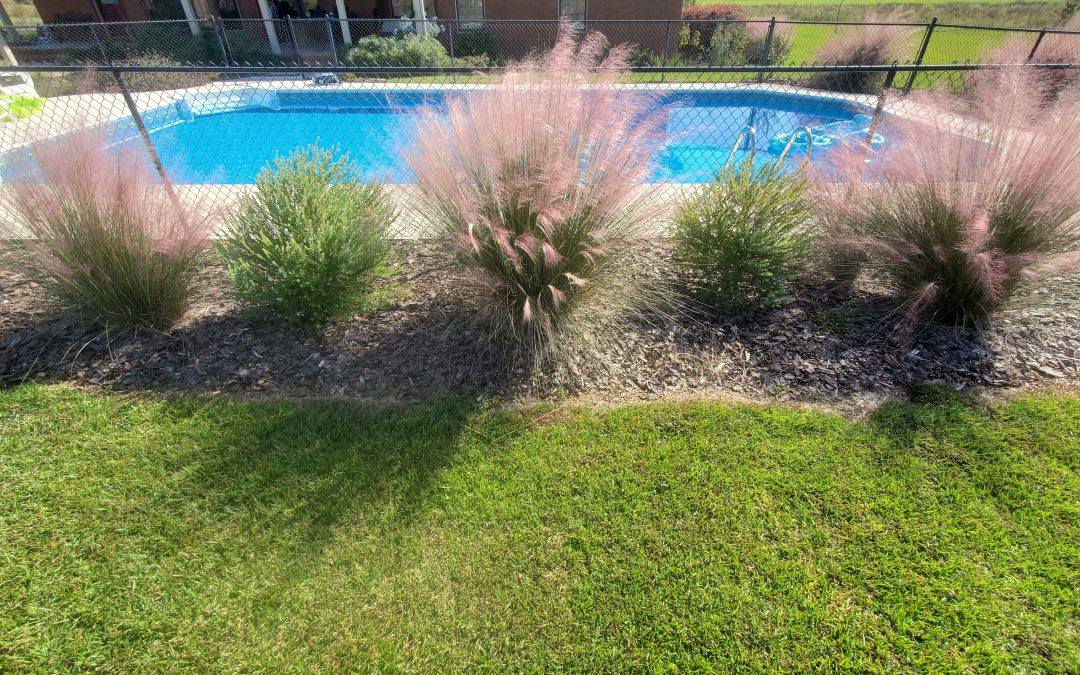
by Daniel J. Leonard | Oct 28, 2020
In the Panhandle, fall is the prettiest season for wildflowers. Our roadsides and woodlands are covered with pinks, whites, yellows, blues, purples, and even a little red here and there. Pretty as it may be, the beautiful wildflower look isn’t super appropriate for most yards. It would look unkempt, a little “wild” if you will, would be hard to manage and is probably best enjoyed in natural areas. However, we can bring some of the native colors of fall into our landscapes in a much lower maintenance, refined manner with two Panhandle species that pair excellently together, Muhly Grass (Muhlenbergia capillaris) and Darrow’s Blueberry (Vaccineum darrowii).
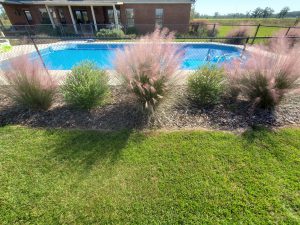
Muhly Grass and Darrow’s Blueberry in a local landscape. Photo courtesy of Daniel Leonard.
Muhly Grass, the native grass with the pinkish/purple panicles blooming right now, has gained much popularity in recent years, earning a reputation as a near pest/disease free, drought tolerant, attractive landscape plant. Operating in lieu of more traditional low growing shrubs in landscapes, Muhly is an airy, greenish gray bunch grass growing about 3-4’ tall and wide, lending informal, coastal texture to landscapes most of the year and really shining in fall during its flowering season. Once established, it never needs extra water, prefers little fertilizer, and only needs a rejuvenation prune (or burn – the Leonard preferred method. It’s fun and mimics the role of fire in Muhly’s native ecosystems!) every couple of years to keep it looking tidy.
Unlike Muhly Grass, Darrow’s Blueberry has not caught on broadly in the landscape industry but is no less deserving. This native blueberry species only grows a couple of feet tall, produces edible fruit that wildlife enjoy, and adds an unusual blue green color to landscapes via its tiny-leaved, evergreen foliage. It prefers the same sites as Muhly and is part of the reason they pair so well together. Our mostly sandy, well drained soils work just fine, but both plants can handle soils that are occasionally wet. A bonus, Darrow’s also has tiny, bell shaped flowers in spring that attract all manner of beneficial bee species. This makes it a must in any native pollinator garden!
As good as these species are alone, I think they are better together. In my family’s yard, we created a loose screen of widely spaced (8’ apart) Muhly Grass specimens around a pool, in the spirit of giving the area a “coastal” airy feel, and interspersed Darrow’s Blueberry in between.
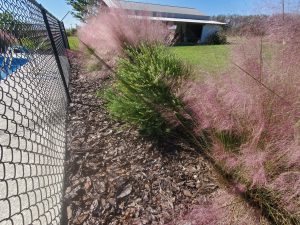
The pink Muhly Grass flowers pair nicely with the green blue foliage of Darrow’s Blueberry. Photo courtesy of Daniel Leonard.
The look has been outstanding, particularly in the late summer/early fall. The pinky purple flowers of Muhly Grass complement the green-blue foliage of the blueberries nicely and provide easy, lasting color without having to worry about planting finicky annuals or perennials each season.
Landscaping with natives does not have to look wild and unkempt, nor does it have to be drab and unattractive. Combining native yet showy plants like Darrow’s Blueberry and Muhly Grass makes for an unusual, refined, nearly no-maintenance feature in your landscape. Look for these and other neat native plants at native nurseries and independent garden centers around the Panhandle. If you’d like more information on native grasses, blueberries or any other horticultural topic, please contact your local UF/IFAS County Extension Office! Happy Gardening!

by Sheila Dunning | Oct 7, 2020
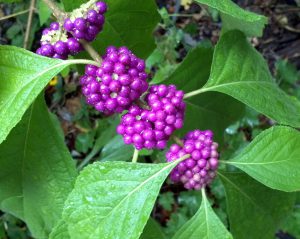
American Beautyberry Photo by: UF/IFAS
Each fall, nature puts on a brilliant show of color throughout the United States. As the temperatures drop, autumn encourages the “leaf peepers” to hit the road in search of the red-, yellow- and orange-colored leaves of the northern deciduous trees. In Northwest Florida the color of autumn isn’t just from trees. The reds, purples, yellow and white blooms and berries that appear on many native plants add spectacular color to the landscape. American Beautyberry, Callicarpa americana, is loaded with royal-colored fruit that will persist all winter long. Whispy pinkish-cream colored seedheads look like mist atop Purple Lovegrass, Eragrostis spectabilis and Muhlygrass, Muhlenbergia capillaris. The Monarchs and other butterfly species flock to the creamy white “fluff” that covers Saltbrush, Baccharis halimifolia. But, yellow is by far the dominant fall flower color. With all the Goldenrod, Solidago spp., Narrowleaf Sunflower, Helianthus angustifolius and Tickseed, Coreopsis spp., the roadsides are golden. When driving the roads it’s nearly impossible to not see the bright yellows in the ditches and along the wood’s edge. Golden Asters (Chrysopsis spp.), Tickseeds (Coreopsis spp.), Silkgrasses (Pityopsis spp.), Sunflowers (Helianthus spp.) and Goldenrods (Solidago spp.) are displaying their petals of gold at every turn. These wildflowers are all members of the Aster family, one of the largest plant families in the world. For most, envisioning an Aster means a flower that looks like a daisy. While many are daisy-like in structure, others lack the petals and appear more like cascading sprays.

Helianthus
So if you are one of the many “hitting the road in search of fall color”, head to open areas. For wildflowers, that means rural locations with limited homes and businesses. Forested areas and non-grazed pastures typically have showy displays, especially when a spring burn was performed earlier in the year. Peeking out from the woods edge are the small red trumpet-shaped blooms of Red Basil, Calamintha coccinea and tall purple spikes of Gayfeather, Liatris spp. Visit the Florida Wildflower Foundation website, www.flawildflowers.org/bloom.php, to see both what’s in bloom and the locations of the state’s prime viewing areas. These are all native wildflowers that can be obtained through seed companies. Many are also available as potted plants at the local nurseries. Read the name carefully though. There are cultivated varieties that may appear or perform differently than those that naturally occur in Northwest Florida. For more information on Common Native Wildflowers of North Florida go to http://edis.ifas.ufl.edu/ep061.
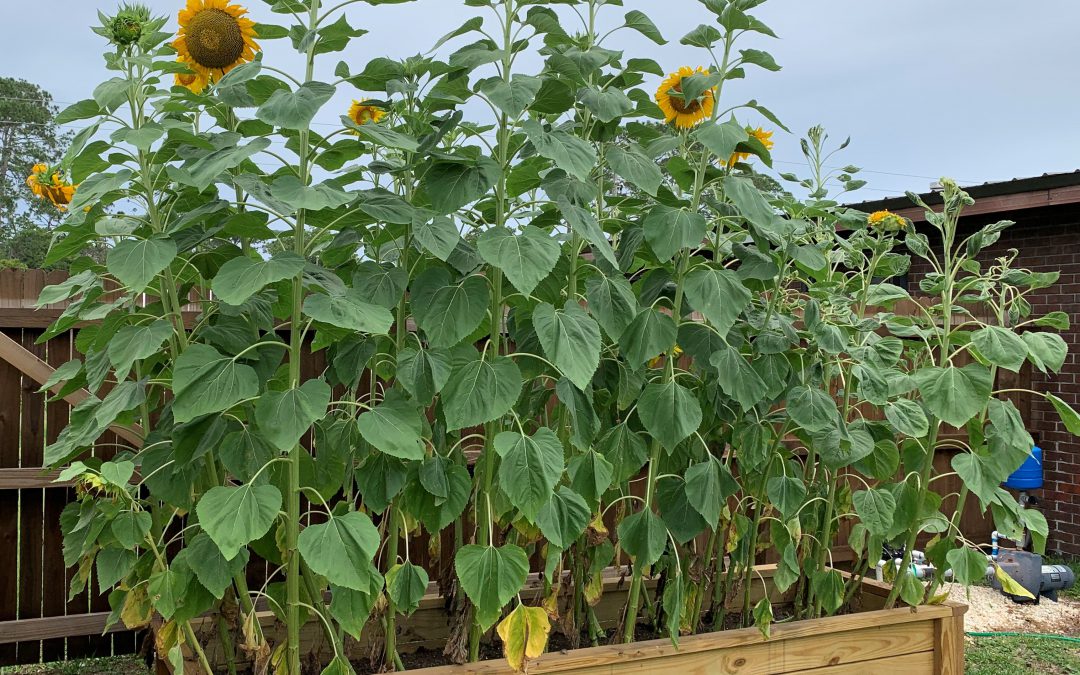
by Ray Bodrey | Jul 1, 2020
Sunflowers, Helianthus spp., are a great choice for gardeners who are looking for some cheerful color in their landscape. Here in Florida, we have the main ingredient for success, lots of sunshine!
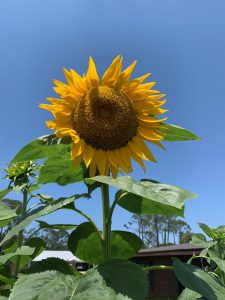
‘Skyscraper’ Sunflower bloom. Photo courtesy of Ray Bodrey.
Sunflowers are short-lived annuals. The average time between planting and bloom is roughly 65 days. You can typically plant sunflowers in Florida beginning in late winter until early fall. Only the coldest months cause problems, and for most years that’s only November – January. Sunflowers can be planted almost anywhere there is full sun. The major selling point with sunflowers is, of course, the impressive blooms (figure 1). These yellow to sometimes orange or red-petaled flowers develop a central seed disc, with most variety’s flowers having approximately an 8” diameter.
When planting, you may choose to plant in narrow rows with close seed spacing in order to cull weaker plants later. A final row and seed spacing of 2’-3’ is recommended for full height and development of most varieties. However, you may also choose to plant in a bed, using a close pattern as seen in the photo below. In any event, sunflowers are easy to propagate by seed and are very low maintenance. Occasionally, powdery mildew and spittle bugs can be a nuisance. A general garden fungicide and insecticide will help if problems occur.
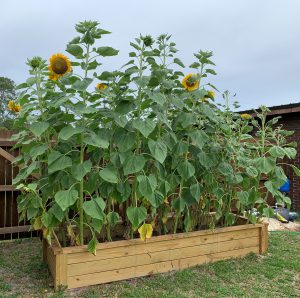
‘Skyscraper’ sunflowers planted on close spacing. Photo courtesy Ray Bodrey.
Sunflowers are available in many varieties, consisting of different color blooms and plant sizes. These sizes range from dwarf (1’-3’) to tall (10’-15’) varieties. You may wish to stake taller varieties at some point, as plants will tend to lean with no wind break in place. Here’s a few garden variety common names to look for: ‘Sunbright’, ‘Sonja’, ‘Sunrich Lemon’, ‘Sunrich Orange’ and ‘Autumn beauty’. Seed companies also have mixes available in packets. For tall plants, ‘Mammoth’ or ‘Skyscraper’ varieties will do the trick.
If you are fond of the sunflower bloom and looking for a groundcover, there are a couple of native perennials that fit this category. Beach sunflower, Helianthus debilis or swamp sunflower, Helianthus angustifolius, are groundcovers/ornamentals for landscapes and thrive in dry, hot climates and in a range of soil types. They also are great pollinator attractors.
For more information on growing sunflowers, contact your local county extension office.
Supporting information for this article and links to other publications on sunflowers can be found at the UF/IFAS Gardening Solutions website: https://gardeningsolutions.ifas.ufl.edu/plants/ornamentals/sunflowers.html
UF/IFAS Extension is an Equal Opportunity Institution.
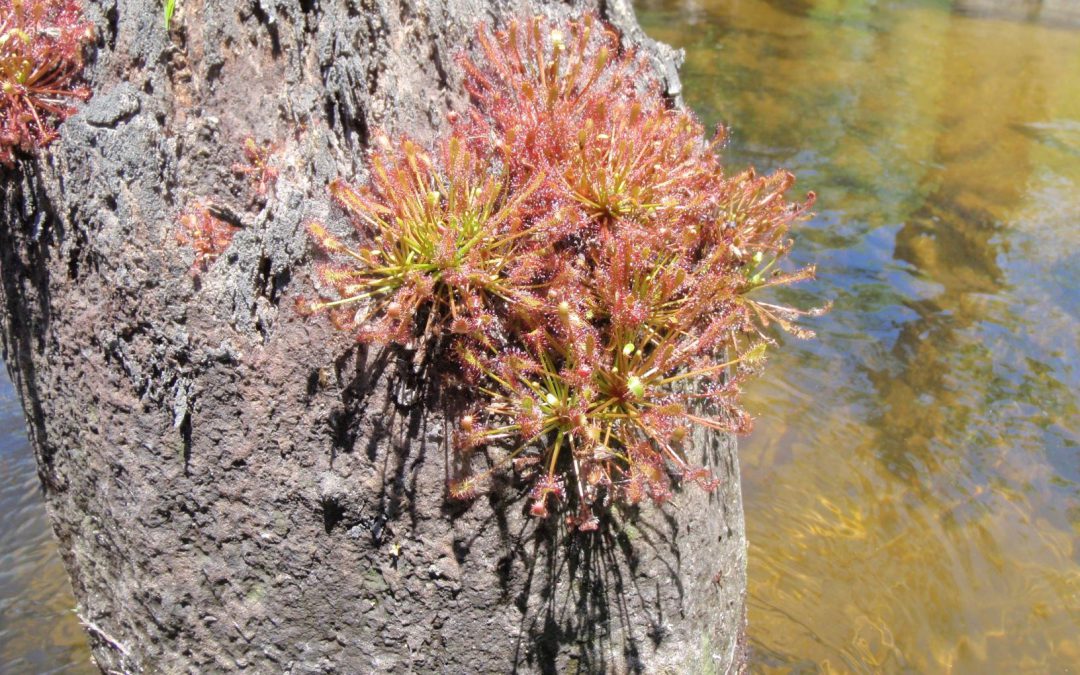
by Carrie Stevenson | Jun 4, 2020
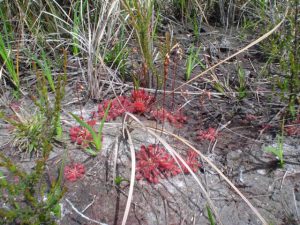
Sundews, tiny carnivorous plants found in pitcher plant bogs, use an enzyme dissolve insect proteins. Native Americans recognized this property and used the plant for skin maladies. Photo credit: Carrie Stevenson, UF IFAS Extension
There are few words better than “pure delight” to describe the face of someone who sees and appreciates a sundew for the first time. Maybe it is their size—often no bigger around than a quarter—or the miniature pinwheel shape, but sundews could easily fit into a fable about garden gnomes or fairies in the woods. These tiny plants hide in plant sight–so small and flush to the ground that you likely won’t see them unless specifically looking for them. But, once you are looking in the right conditions, you will probably see them everywhere.
Sundews (Drosera spp.) are small carnivorous plants found in the same bogs as pitcher plants. They thrive in moist, mucky soil and full sun. They are also carnivorous for the same reasons pitcher plants are—their wet, acidic habitats possess few soil nutrients, so they use insects instead.
Sundews utilize a different method for trapping insects—their flat, radiating structure has wider lobes on the ends, which are covered with hairlike tentacles. These hairs secrete droplets of sticky sap visible at the tip of each hair. Small insects are attracted to the dewlike sap and get stuck. The hairs curl around the insect like a slow Venus flytrap, and natural enzymes to break down the bug.
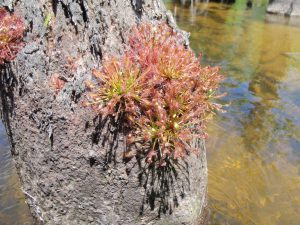
A healthy sundew plant growing just above the water level at Boiling Creek in Santa Rosa County. Photo credit: Larry Burner, Florida Master Naturalist
There are almost 200 species of sundews, not all with the flat growth pattern. The threadleaf sundew has an upright structure, while others may grow in a spherical shape at the water’s edge. While paddling Boiling Creek on Eglin Air Force Base property a few years ago, our group saw dozens of sundews growing on the trunks of cypress and tupelo trees at eye-level from our kayaks. They were about 4-6” in diameter, much larger than the 1” ones we typically see in the bogs.
Tarkiln State Park, Weeks Bay National Estuarine Research Reserve, or any place you find pitcher plants are a great place to find sundews. You may have to get on your knees to see them, and move the grasses aside. Bring a hand lens to magnify the delicate details of the droplets of sap perched at the tip of tiny hairs.
Even the famous naturalist Charles Darwin was enthralled with sundews, conducting experiments and writing volumes about them. In an 1860 letter to his geologist friend Charles Lyell, Darwin stated that, “at the present moment, I care more about Drosera than the origin of all the species in the world.” If you, too, are fascinated with carnivorous plants, check out these resources from UF IFAS Extension and the Botanical Society of America.
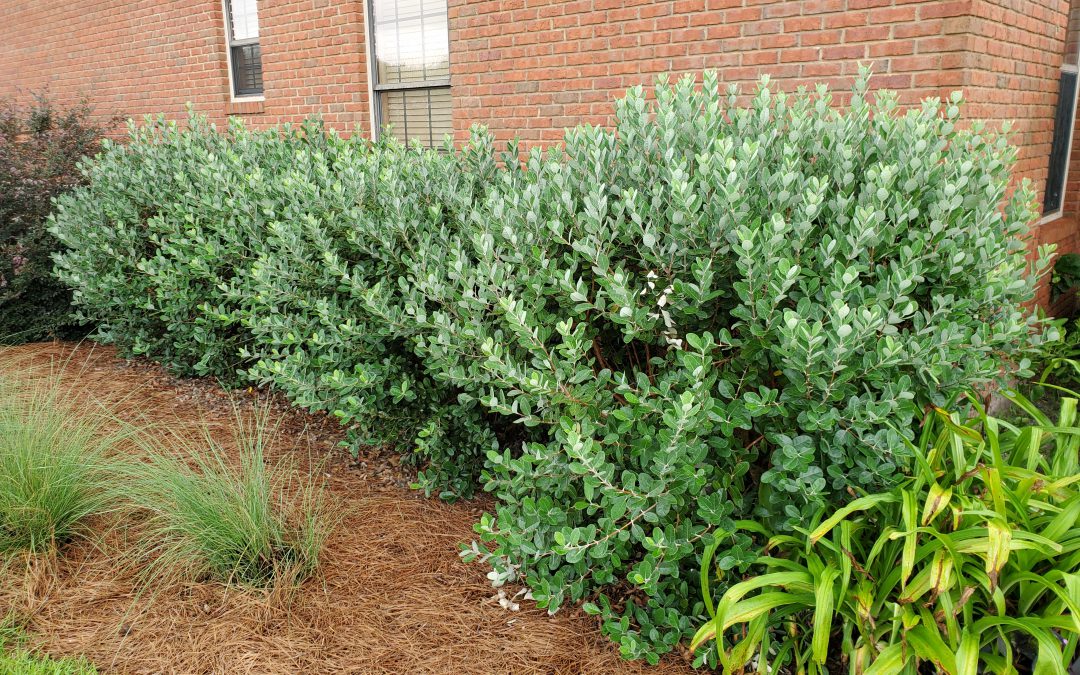
by Daniel J. Leonard | Jun 2, 2020
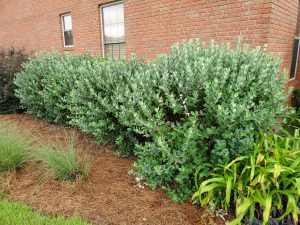
Pineapple Guava (Acca sellowiana) hedge. Photo courtesy of the author.
One of the most common questions I’ve gotten across the Panhandle over the last several years is “What can I plant to screen my house and property?” I surmise this has a lot to do with Hurricane Michael wiping properties clean and an explosion of new construction, but whatever the reason, people want privacy, they want it quickly, and they often want something a little more natural looking and aesthetically pleasing than a fence. Like everything else, the answer to the question is nuanced depending on the site situation. However, if the situation is right, I almost always recommend that clientele at least consider a woefully underutilized plant in the Panhandle, Pineapple Guava (Acca sellowiana).
Named a Florida Garden Select Plant by the Florida Nursery Growers and Landscape Association (FNGLA) in 2009, Pineapple Guava is a standout screening and specimen plant, passing all the usual tests homeowners demand from shrubs. Growing 15’x15’ or so if never pruned or sheared, these quick-growing evergreen shrubs sport pretty, leathery green leaves with gray to white undersides. This leaf underside coloring causes the plants to emit a striking silvery blue hue from a distance, a very unusual feature in the screening shrub world.
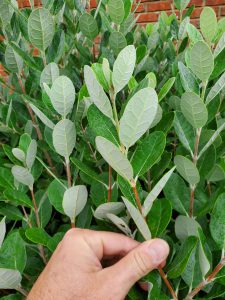
Pineapple Guava (Acca sellowiana) silvery blue leaf undersides. Photo courtesy of the author.
Look past the leaves and you’ll notice that Pineapple Guava also possesses attractive brownish, orange bark when young that fades to a pretty, peely gray with age. To complete the aesthetic trifecta, in late spring/early summer (generally May in the Panhandle), the plants, if not heavily sheared, develop gorgeous edible, pollinator-friendly flowers. These flowers, comprised of white petals with bright red to burgundy stamens in the center, then develop over the summer into tasty fruit that may be harvested in the fall.
In addition to being a superbly attractive species, Pineapple Guava is extremely easy to grow. They like full, all-day, blazing sunshine but will tolerate some shading if they receive at least six hours of direct sun. Well-drained soil is also a must. Pineapple Guava, like many of us, is not a fan of wet feet! Site them where excessive water from rain will drain relatively quickly. Adding to its merits, the species is not plagued by any serious pests or diseases and is also drought-tolerant, needing no supplemental irrigation once plants are established. A once a year application of a general-purpose fertilizer, if indicated by a soil test, may be useful in getting plants going in their first couple of years following planting, but is rarely necessary in subsequent years. To maintain Pineapple Guava as a formal hedge or screen, a simple shear or two each growing season is normally enough. The species also makes an outstanding small specimen tree when allowed to grow to its mature height and “limbed-up” to expose the interesting bark and limb structure.
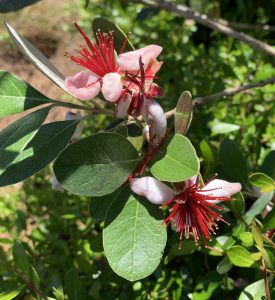
Edible, pollinator-friendly Pineapple Guava flowers in bloom. Photo credit: Larry Williams
If you’ve been looking for a quick-growing, low-maintenance screen or a specimen plant for a large landscape bed, you could do a lot worse than the Florida-Friendly Pineapple Guava! As always, if you have any questions about Pineapple Guava or any other horticulture, agriculture or natural resource related issue, contact your local UF/IFAS County Extension Office!















